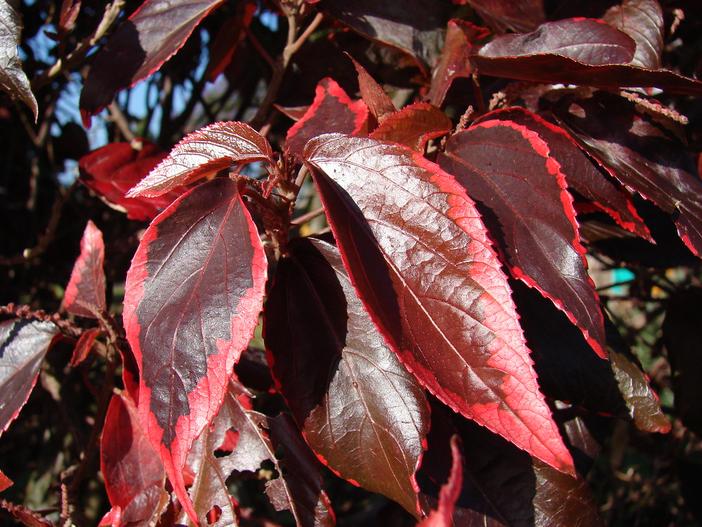Copperleaf
(Acalypha wilkesiana)
Copperleaf (Acalypha wilkesiana)
/
/

Forest and Kim Starr
CC BY 2.0
Image By:
Forest and Kim Starr
Recorded By:
Copyright:
CC BY 2.0
Copyright Notice:
Photo by: Forest and Kim Starr | License Type: CC BY 2.0 | License URL: https://creativecommons.org/licenses/by/2.0/ | Uploader: Starr Environmental | Publisher: Flickr






















































































Estimated Native Range
Summary
Acalypha wilkesiana, commonly known as Copperleaf, is an evergreen shrub native to the tropical forests, rainforests, and savannahs of Melanesia and Polynesia. It can reach up to 3 meters (9.8 ft) in height and 2 meters (6 ft 7 in) across, with a closely arranged crown, erect stem, and many branches. The foliage is its most striking feature, with leaves that are coppery green with red splashes, providing a mottled and vibrant appearance. The leaves and branches are covered in fine hairs, adding to its textured look.
Copperleaf is valued for its year-round color in tropical climates and is used in mixed hedges, shrub borders, and as a specimen shrub. In non-tropical regions, it is often grown as an annual, where its foliage offers a colorful alternative to flowers from late summer until frost. As an indoor plant, it requires a warm, humid, and bright environment. It thrives in light, well-drained soil, and prefers a protected shady position when planted outdoors. Copperleaf is sensitive to both drought and frost and requires a minimum temperature above 10 °C (50 °F). For outdoor cultivation, it does best in rich, moist, but well-draining soil, while indoor plants benefit from a soilless potting mix that is kept consistently moist but not waterlogged. Daily misting is recommended for indoor plants, with reduced watering in winter. It is best suited to USDA hardiness zones 10-12 and generally does best in full sun to part shade.CC BY-SA 4.0
Copperleaf is valued for its year-round color in tropical climates and is used in mixed hedges, shrub borders, and as a specimen shrub. In non-tropical regions, it is often grown as an annual, where its foliage offers a colorful alternative to flowers from late summer until frost. As an indoor plant, it requires a warm, humid, and bright environment. It thrives in light, well-drained soil, and prefers a protected shady position when planted outdoors. Copperleaf is sensitive to both drought and frost and requires a minimum temperature above 10 °C (50 °F). For outdoor cultivation, it does best in rich, moist, but well-draining soil, while indoor plants benefit from a soilless potting mix that is kept consistently moist but not waterlogged. Daily misting is recommended for indoor plants, with reduced watering in winter. It is best suited to USDA hardiness zones 10-12 and generally does best in full sun to part shade.CC BY-SA 4.0
Plant Description
- Plant Type: Shrub
- Height: 2-4 feet
- Width: 2-4 feet
- Growth Rate: Moderate
- Flower Color: N/A
- Flowering Season: Spring, Summer, Fall
- Leaf Retention: Evergreen
Growth Requirements
- Sun: Full Sun, Part Shade
- Water: Medium
- Drainage: Fast
Common Uses
Bird Garden, Hedges, Low Maintenance, Potted Plant
Natural Habitat
Tropical forests, rainforests, and savannahs
Other Names
Common Names: Wilkes’ Acalypha, Jacob’s Coat, Capa De Obispo, Match Me If You Can, 威氏鐵莧
Scientific Names: , Acalypha wilkesiana, Acalypha godseffiana, Acalypha marginata, Acalypha amentacea subsp. wilkesiana, Acalypha wilkesiana var. marginata, Acalypha godseffiana var. heterophylla, Acalypha hamiltoniana, Acalypha wilkesiana f. macrophylla, Acalypha compacta
GBIF Accepted Name: Acalypha wilkesiana Müll.Arg.